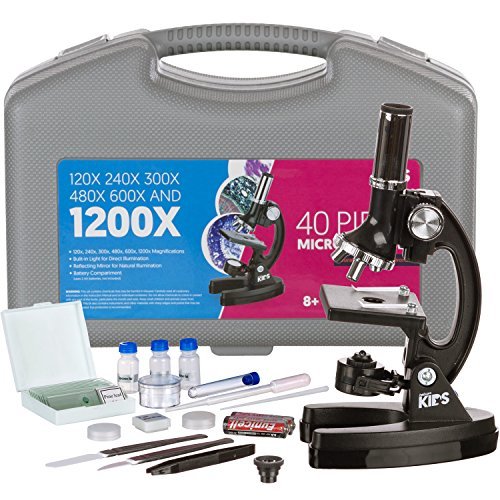
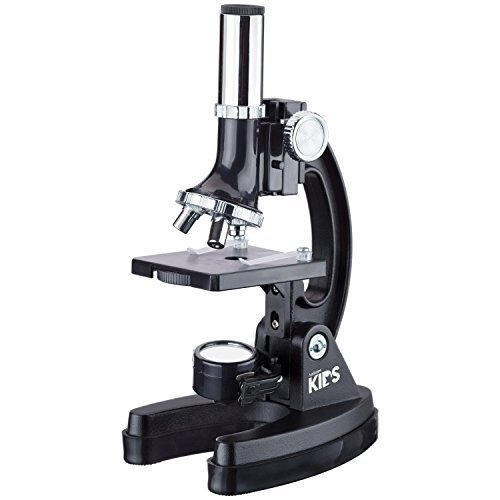
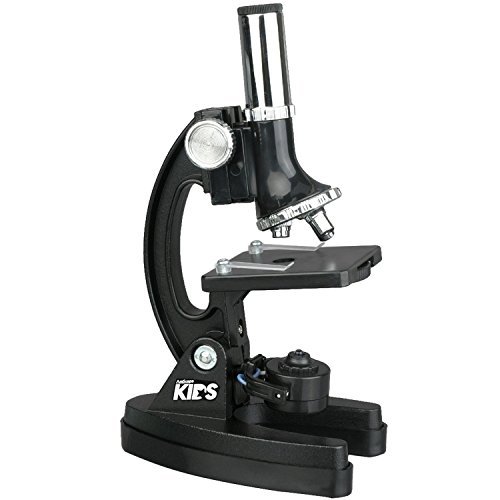
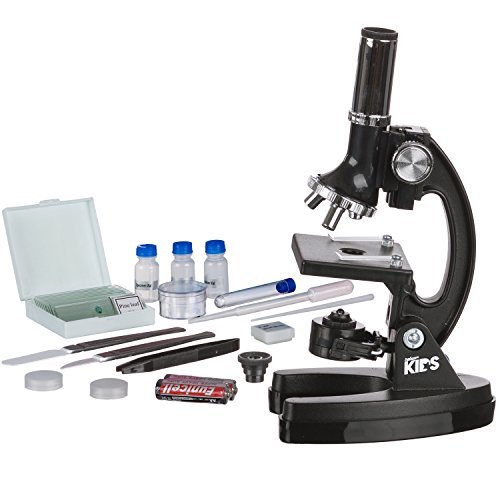
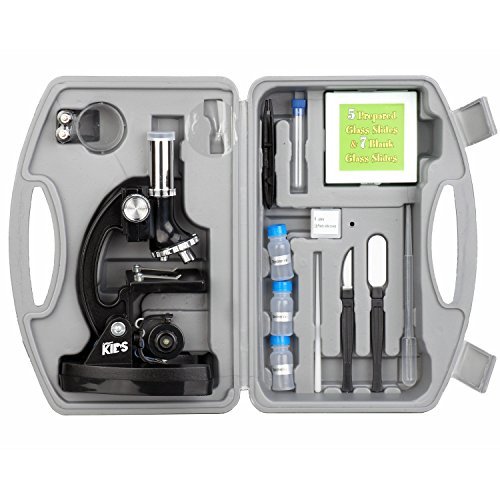
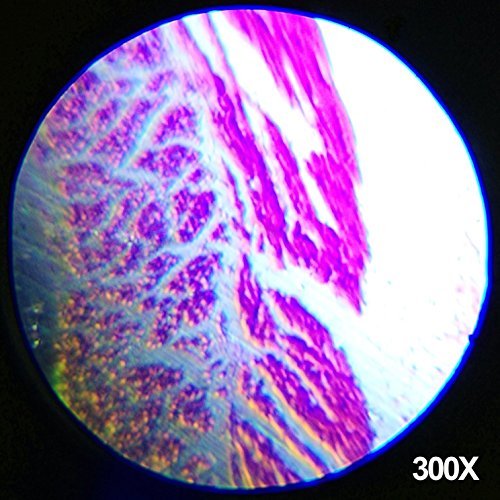
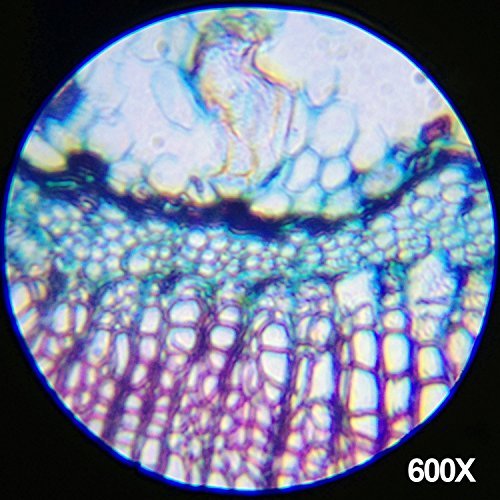







Comes with 48-piece accessory kit and hard-sided plastic carrying case
The AmScope M30-ABS-KT1 beginner compound microscope has a monocular viewing head with LED and mirror illumination, a built-in color-filter wheel, a forward-facing rotating turret with 300x, 600x, and 1200x magnification, and a black metal frame. The monocular viewing head has LED and mirror illumination and a built-in color-filter wheel for viewing a variety of specimen types. Coaxial coarse focus eases use for young users and has a rack-and-pinion focus mechanism for precise focusing. The plain stage has stage clips that secure the slide or specimen in place during viewing. The black metal frame is durable and stain-resistant. The microscope comes with a 48-piece accessory kit and a hard-sided plastic carrying case. The LED light is powered by two AA batteries (included).
Specifications Head Monocular Magnification 300x, 600x, 1200x Stage Plain Focus Coaxial coarse Light source LED and Incidental Power AA batteries (2)
Microscopes are instruments used to enhance the resolution of an object or image. Types include compound, stereo, or digital. Compound microscopes use a compound optical system with an objective lens and an eyepiece. Stereo microscopes show object depth in a three-dimensional image. Digital microscopes are used to display an image on a monitor, rather than looking through a lens. Microscopes can have monocular (one), binocular (two), or trinocular (three) eyepieces, with varying magnification abilities. Magnification ability refers to the size of an image. Resolution, also known as resolvant power, refers to the clarity of the image. The interaction between field of view (FOV), numerical aperture (NA), and working distance (WD) determines resolution. Microscopes can control magnification through a fixed focus, or through a range of adjustments. They can also utilize LED, fluorescent, and mirror light sources to help control viewing capabilities. Microscopes are widely used in education, lab research, biology, metallurgy, engineering, chemistry, manufacturing, and in the medical, forensic science, and veterinary industries.
United Scope manufactures microscopy equipment and accessories under the brand name AmScope. The company, founded in 1996, is headquartered in Irvine, CA.
What’s in the Box? AmScope M30 microscope Specimen slicer Petri dish Plastic tweezers Plastic scalpel Plastic spatula Needle Plastic stirring rod Eosin (5) Prepared slides (7) Blank slides (16) Slide covers (8) Slide labels (3) Collecting vials (2) AA batteries Spare LED bulb Plastic carrying case
When I first opened this gift for my nephew (to inspect for quality before I gave it to him), I couldn’t see ANYTHING. However, my partner, who is a medical doctor, then helped me learn how to use it, and I can see everything beautifully now. This product has a lot of great potential, but to utilize it you will need to practice a few “ticks.” I have some tips for users and tips for AmScope.Tips for Users (please read all the tips before attempting a view):1) In order to see the prepared slides, you must begin on the lowest magnification, find the sample, focus the view, and then graduate to the next highest setting, repeating the find/focus process (but do not attempt this until you’ve read all the “tips”). You will not be able to find most samples if you start on a higher setting.2) Do not press on, hold, or touch the viewing column (the neck of the microscope that you peer into) while focusing or viewing a slide. If you do, it will bump the lens away from what you are trying to see and you won’t be able to maintain focus. The only part of the microscope you should touch is the actual focus knob. This may be tough for kids, but it’s a good skill to learn.3) If you see part of the slide, but want a fuller view, move the slide in the opposite direction than what it looks like you should (that is, if it looks like the slide needs to go down, move it up; same for Left vs. Right). The instruction manual doesn’t mention this, but it’s a very important, elementary fact that will drive you batty if you don’t know it.4) You are going to see, what appears to be, light grey, transparent dots and circles when you peer into the lens, and when you view the slides. That is OK. All microscopes have these blemishes to some extent. You will not get rid of them. However, this should NOT impair your ability to view and focus on each slide so that you see their cells, bright colors, and sharp detail. When the microscope is properly focused, these grey blotches do not block or inhibit an excellent view of the specimen (when properly focused, you don’t really even notice them). But, if you are not able to focus, almost all you will see is these grey blotches.You can clean the lenses with alcohol to remove some external dust or grime, but no matter what there will always be some debris (it’s a microscope: it blows everything up, including dust and water marks). So, before assuming it’s a problem with the lens, make sure you get a good focus (following the steps below) and see if your view is actually blocked. It shouldn’t be. My husband works with industrial grade microscopes and he says all of them have this effect, to some extent.5) My Corn root slide is hopeless. With a lot of work, my husband was able to get a view of it, but it was barely visible even then; so, don’t try that one first (you’ll assume the microscope doesn’t work). Try the darkest specimen and then once you have the knack of it, move to the more transparent ones. They are all BEAUTIFUL once you can get a good focus (except the corn root).Tips for AmScope:1) Ditch the corn root sample and replace it with something larger. It is almost impossible to see.2) Improve your instruction manual to include directions about how to focus, beginning from the lowest setting, and informing folks not to touch the viewing column.3) Include three images in your instruction manual of what they should see with no specimen (including the grey blotches), what an unfocused specimen could look like, and what a sharp, focused image should look like. These can be grey scale, and would provide some guidance.(PS: I’m a technical writer, so let me know if you need someone to improve your instruction manuals).So, here are my version of written instructions for viewing a sample slide:1. Place your slide under the viewer.2. Do not touch any part of the microscope other than the focus knob while viewing your specimen.3. Begin on the lowest magnification (300x). Adjust the slide until you see at least a shadow of the specimen in the viewer, and then slowly turn the focus knob until you can clearly see the specimen (you should be able to see some definition between cells).4. If you see the specimen in part of your viewing circle, but want to see more, move the slide in the opposite direction than it appears that you should (eg: if it looks like you should move it down, move it up).5. Once you have a clear view, you can increase your magnification to 600X.6. Note: when you turn the lens to the next setting, your view of the specimen will change (as the lens will be lined up slightly differently). You can shift the slide again, or you can gain focus, and then move the slide. Remember not to bump or lean on the viewing column, as it will cause you to loose focus.Hope this helps.
This was a perfect little kit, the only reason it gets 4 stars is because the snaps on the case that lock the box closed are VERY fragile & break easily. My daughter took this to a science contest & she had a blast with it. I like that it comes with both prefilled slides and empty ones! Super Excited about this purchase!
This was for my first-grade granddaughter who LOVES IT. She has always said she wants to be a teacher, now she wants to be a scientist! EXCELLENT LITTLE MICROSCOPE FOR THE MONEY.
My friend’s daughter’s birthday is 2 weeks later, this is a perfect gift for her. So glad I bought it, I’m sure she will like it .
Bought for my grandson we had a lot of trouble getting focus get the light to get there correctly and the slights weren’t good at all. He wanted to see some interesting and wow and he didn’t get that. Since I bought it early for his birthday I passed my 30 day return. Now it just sits in the closet.
Christmas gift for my niece. Also purchased some prepared samples for her to learn how to use a microscope. It is plastic, except for the arm but images are surprisingly clear. We are all very pleased with this purchase.
The brackets for the light were broken and the lenses crackeds.
Our Grand daughter loved the microscope and has used it a lot.
Cheap plastic , led backlight broken
This microscope is good enough for my kids. They were so excited when they got it. It is lightweight but looks so cool with 48-piece accessory kit.
Great for the price
Perfect for my scientific little 6-year old. Works well and light and easy to use. He loves it!
My nephews were so interested in microscope when they watched a scientist documentary. My nephews said they wish to be scientists, and use the microscope all the time.
Comes with a nice case and accessories. Bought this for my son. I’m a beginner. So I have to figure out how to use it before I teach my son.
My daughter was studying the microscope and carried this one every where she went she passed all the tests and assignments using this one as a guide.
Great little microscope. I got this for my5 year old son. Compared with its price is good quality. It goes with a nice case to protect itself, so it is very nice.
It’s so cute, my sister’s son really like it. He is almost 5 years old. This is a good item to help him know and interest in science and technology.
comments powered by Disqusbroke second day